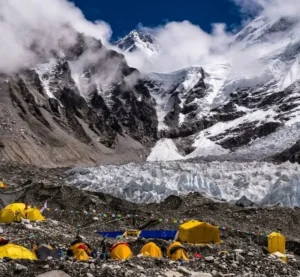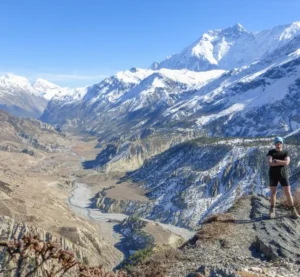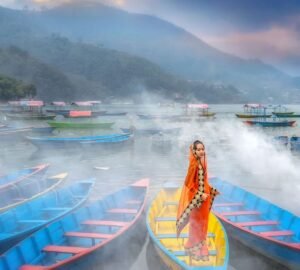Nepal
UTC+5:45 (Nepal Time)
One of few time zones with a 45-minute offset
No daylight saving time observed
Nepalese Rupee (NPR)
Symbol: रू (international: Rs)
Indian Rupee widely accepted in many areas
Modern unification in 1768 by King Prithvi Narayan Shah
Republic established in 2008 after abolition of monarchy
Only South Asian nation never colonized by European powers
Visa on arrival available for most nationalities
Online visa application option before arrival
Special permits required for certain trekking regions
Culture
Nepal's culture is a rich tapestry woven from the traditions of more than 100 ethnic groups and castes, each with distinct customs, languages, and religious practices. This diversity, combined with Nepal's geographic isolation until the mid-20th century, has preserved ancient traditions while allowing for fascinating cultural synthesis.
Key elements of Nepalese culture include:
- Religious harmony: Hinduism (81.3%) and Buddhism (9%) exist in remarkable harmony, with many religious sites venerated by both faiths. Indigenous shamanic traditions, Islam, and Christianity also contribute to Nepal's spiritual landscape. This religious syncretism is epitomized by the concept of Buddha as an avatar of Vishnu in many Nepalese beliefs.
- Festivals: Nepal celebrates more than 50 major festivals throughout the year. Dashain (15-day celebration of the goddess Durga's victory over evil) and Tihar (five-day festival of lights) are the most important national celebrations. Kathmandu Valley's Newari community observes numerous unique festivals, including the chariot processions of Indra Jatra and Machhindranath Jatra.
- Art and architecture: Nepalese art reflects strong Hindu and Buddhist influences, particularly visible in the pagoda-style temples (which Nepal actually exported to China) and religious statuary. The Kathmandu Valley's seven UNESCO World Heritage Sites showcase the exquisite wood carving, stone sculpture, and metalwork of Newar artisans, whose techniques have been passed down through centuries.
- Music and dance: Traditional music features distinctive instruments like the sarangi (string instrument), madal (drum), and flutes. Each ethnic group has its own dance traditions, from the Newari Lakhey masked dances to the Tamang people's Selo and the Sherpa community's Shabru dance.
- Craft traditions: Nepal is renowned for textiles like pashmina and dhaka, metalwork including singing bowls and khukuri knives, thangka painting (Buddhist religious scrolls), pottery, and woodcarving – many of these ancient crafts are still practiced using traditional methods.
Nepalese cuisine varies by region and ethnicity, though certain elements are widespread:
- Dal Bhat: The national dish and daily staple consisting of lentil soup, rice, and vegetable curries, often accompanied by pickles (achar) and sometimes meat
- Momos: Steamed or fried dumplings filled with meat or vegetables, served with spicy dipping sauce
- Newari cuisine: The sophisticated culinary tradition of the Kathmandu Valley, featuring dishes like choila (spiced grilled meat), bara (lentil patties), and yomari (sweet rice flour dumplings)
- Highland dishes: Sherpa and Tibetan-influenced foods like thukpa (noodle soup), tsampa (roasted barley flour), and butter tea found in mountain regions
- Street foods: Chatamari (rice flour "pizza"), sel roti (sweet rice flour bread), and samosas are popular quick meals in urban areas
Social life in Nepal centers around family and community. The traditional joint family system remains common, with multiple generations living together under one roof. Respect for elders is paramount, and family obligations take precedence over individual pursuits. While modernization and global influences are gradually shifting some of these patterns, particularly in urban areas, Nepal's strong cultural identity and traditions continue to shape daily life throughout the country.
Tourism & Best Sites to Visit
Nepal offers extraordinary diversity for travelers, from the world's highest mountains to subtropical jungles, ancient temples to living cultural traditions. The country's compact size belies its remarkable range of experiences, often described as having "something for everyone" despite its landlocked, mountainous geography.
Here are some of Nepal's most compelling destinations:





Everest Base Camp: The iconic trek to the foot of the world's tallest mountain (8,848.86 meters) offers unparalleled high-altitude landscapes and insights into Sherpa culture. The two-week journey takes trekkers through picturesque villages, dramatic valleys, and Buddhist monasteries, culminating in views of Everest and its neighboring peaks from Kala Patthar (5,545m).
Kathmandu Durbar Square: The former royal palace complex and surrounding plazas in Nepal's capital showcase extraordinary Newari architecture with intricately carved wooden balconies, stone sculptures, and pagoda-style temples. Though damaged in the 2015 earthquake, restoration continues, and the square remains the historic heart of Kathmandu and an essential window into Nepal's architectural heritage.
Annapurna Circuit: One of the world's classic treks, this 160-230 km route encircles the Annapurna massif, crossing a 5,416m pass (Thorong La) and passing through diverse ecological zones from subtropical forests to high alpine terrain. The trek showcases remarkable cultural diversity with Hindu villages in lower elevations and Tibetan Buddhist communities in higher regions.
Pokhara: Nepal's second-largest city sits beside tranquil Phewa Lake with the snow-capped Annapurna range creating a stunning backdrop. The city serves as the gateway to the Annapurna region while offering its own attractions, including paragliding, boating, the World Peace Pagoda, and a relaxed atmosphere that contrasts with Kathmandu's urban energy.
Chitwan National Park: This UNESCO World Heritage site in Nepal's lowland Terai region protects a biodiverse subtropical ecosystem. Wildlife safaris by jeep, foot, or elephant offer opportunities to spot Bengal tigers, one-horned rhinos, sloth bears, and over 500 bird species. The park also provides insight into the culture of the indigenous Tharu people.
Other notable destinations include Lumbini (birthplace of Buddha), Bhaktapur (the best-preserved medieval city in the Kathmandu Valley), Upper Mustang (a restricted region with Tibetan culture and high desert landscapes), Langtang Valley (offering excellent trekking closer to Kathmandu), and Janakpur (center of Maithili culture and site of the magnificent Janaki Temple).
Transportation
Nepal's mountainous terrain presents unique transportation challenges, with options ranging from modern domestic flights to traditional animal caravans in remote regions. The country's infrastructure continues to develop, though certain areas remain accessible only by foot or helicopter.
- Domestic flights: The fastest way to reach major destinations in Nepal, with flights connecting Kathmandu to regional hubs like Pokhara (25 minutes vs. 7+ hours by road), Lukla (gateway to Everest), Bharatpur (for Chitwan), and other locations. Airlines like Buddha Air, Yeti Airlines, and Saurya Airlines operate modern turboprop aircraft. Weather conditions often cause delays or cancellations, particularly in mountain airports during monsoon season.
- Buses: The primary mode of long-distance transport for most Nepalis and budget travelers. Options range from basic local buses that stop frequently to tourist-oriented services with more comfort and fewer stops. The "Green Line" and similar premium services connect major tourist destinations with air-conditioned buses. Mountain roads are often narrow and winding, and lengthy travel times should be expected – the 200km journey from Kathmandu to Pokhara takes 7-9 hours.
- Jeeps and shared taxis: Four-wheel drive vehicles serve routes where regular buses don't operate, particularly to trailheads and more remote destinations. These typically depart when full rather than on fixed schedules, making them less predictable but often faster than buses.
-
Urban transportation: Within cities, options include:
- Taxis: Readily available in Kathmandu, Pokhara, and other tourist centers, usually with meters (though negotiation is often required)
- Tempos: Three-wheeled auto-rickshaws that operate on fixed routes in larger cities
- Microbuses: Small vans serving fixed urban routes
- Ride-hailing apps: Pathao and Tootle operate in Kathmandu, offering motorcycle and car services
- Trekking: Many of Nepal's most spectacular destinations require trekking on foot. Well-established trekking routes like the Everest Base Camp trek and Annapurna Circuit feature a network of teahouses (simple lodges), while more remote regions may require camping and porters. Permits are required for all major trekking areas.
Transportation tips: Nepal's transportation system requires flexibility and patience:
- Allow generous buffer time in itineraries, especially during monsoon season (June-September) when landslides can block roads
- Book domestic flights in advance during peak tourist seasons (October-November and March-April)
- Consider hiring a private vehicle with driver for multi-day trips if your budget allows
- For trekking regions, check whether permits can be obtained locally or must be arranged in Kathmandu
- The condition of roads varies dramatically – major highways are generally paved, while secondary roads may be rough, particularly after the monsoon
Safety considerations: Nepal's challenging geography means transportation safety requires attention. Choose reputable airlines for domestic flights, use tourist-class buses for long journeys when possible, and be selective about taxis and other vehicles based on their condition. During festivals and major holidays, transportation becomes extremely crowded, and advance planning is essential.
Airports
Nepal has one international airport and numerous domestic airports, many serving mountain regions where road access is limited or time-consuming. These airports play a vital role in connecting remote areas and facilitating tourism, though operations can be affected by Nepal's challenging mountain weather.
- Tribhuvan International Airport (KTM): Located in Kathmandu, this is Nepal's sole international gateway and main aviation hub. Despite ongoing improvements, the facilities remain relatively basic by international standards. The airport handles flights from major Asian cities, the Middle East, and limited direct connections to Europe. The domestic terminal operates separately and serves as the connection point for flights to regional destinations.
- Gautam Buddha International Airport (BWA): Nepal's second international airport, located near Lumbini (birthplace of Buddha). Opened in 2022, it currently handles limited international flights but is expected to expand service over time.
- Pokhara International Airport (PKR): A new facility opened in 2023 to replace the older domestic airport. Located near Nepal's second-largest city and adventure tourism hub, it has begun handling some international flights, particularly regional connections.
-
Important domestic airports:
- Lukla Airport (Tenzing-Hillary Airport): The gateway to the Everest region and often called the world's most dangerous airport due to its short runway on a mountain slope
- Jomsom Airport: Serving the Annapurna and Mustang regions
- Bharatpur Airport: Access point for Chitwan National Park
- Simara, Biratnagar, and Nepalgunj Airports: Serving major regional cities
Airport Transportation: Options for reaching your destination from airports include:
- Tribhuvan International Airport (Kathmandu): Located about 6 km from the city center. Pre-paid taxi counters offer fixed-rate services into the city. Hotel transfers can be arranged in advance. Public buses stop near the airport entrance, though they can be difficult to navigate for first-time visitors.
- Regional airports: Most have taxi services available, though in tourist destinations like Pokhara, hotels often provide complimentary transfers if booked in advance. At trekking destinations like Lukla, transportation is usually on foot to nearby villages.
Important notes: Mountain airports in Nepal often experience weather-related delays and cancellations, particularly during monsoon season and winter mornings when fog can affect visibility. When planning itineraries that include domestic flights, it's advisable to include buffer days, especially before international departures. Baggage allowances on small aircraft serving mountain airports are strictly limited (usually 10-15kg total), with excess charged by weight.
Visa & Travel Information
Nepal has implemented tourist-friendly visa policies to encourage visitors, with options for obtaining visas both before arrival and upon entry at major ports. Most nationalities require a visa, though the process is straightforward.
Visa Options by Nationality
The following table outlines visa requirements for visitors to Nepal:
| Nationality | Visa Requirement | Notes |
|---|---|---|
| Most Countries (including USA, EU, UK, Australia, Canada, etc.) | Visa on Arrival | Available at Tribhuvan International Airport and major land borders |
| India | No Visa Required | Indian citizens can enter with any photo ID proving citizenship |
| China | Visa on Arrival | Fee waiver for Chinese tourists (though visa still required) |
| SAARC Countries (except India) | Visa on Arrival | Available at entry points |
| Nigeria, Ghana, Zimbabwe, Swaziland, Cameroon, Somalia, Liberia, Ethiopia, Iraq, Palestine, Afghanistan | Visa Required Before Arrival | Must obtain visa from Nepali diplomatic mission |
Visa on Arrival Process: Available at Tribhuvan International Airport in Kathmandu, Gautam Buddha International Airport, and major land border crossings. The process involves:
- Completing an online form before arrival (at online.nepalimmigration.gov.np) or filling out a form at the airport
- Payment of visa fee (varies by duration):
- 15 days: US$30
- 30 days: US$50
- 90 days: US$125
- Providing a passport-sized photo (though this can often be avoided by applying online)
- Having a passport valid for at least six months with at least one blank page
Trekking permits: Beyond the standard visa, certain areas require additional permits:
- TIMS Card (Trekkers' Information Management System) - required for most trekking areas
- Conservation Area Permits for national parks and protected areas (e.g., Annapurna, Sagarmatha)
- Special permits for restricted regions like Upper Mustang, Upper Dolpo, and Kanchenjunga
Important Travel Considerations
- Health precautions: No vaccinations are mandatory for entry, though hepatitis A, typhoid, and Japanese encephalitis vaccines are recommended. Altitude sickness is a concern for mountain regions, with proper acclimatization essential. Bottled or purified water is advised throughout Nepal.
- Money: ATMs are widely available in Kathmandu, Pokhara, and other tourist areas, though service can be unreliable and withdrawal limits are often low. Credit cards are accepted at better hotels and restaurants in major cities, but cash is essential for rural areas and trekking. It's illegal to import or export Nepalese Rupees, so currency exchange occurs within the country.
- Safety: Nepal is generally safe for travelers with normal precautions. The biggest risks are related to adventure activities and natural hazards (altitude, weather, etc.). Be cautious about drinking water quality and food hygiene, particularly outside major tourist areas.
- Communications: SIM cards are inexpensive and available with passport identification. Coverage is good in population centers but limited in mountain regions. Many teahouses and lodges along major trekking routes offer Wi-Fi, though connection quality varies greatly.
Best time to visit: Nepal has distinct seasonal patterns:
- October-November: The peak season with clear skies, moderate temperatures, and excellent mountain views. Ideal for trekking but accommodations can be crowded.
- March-April: The second-best season, featuring spring rhododendron blooms in the mountains. Weather is warm with good visibility, though hazier than autumn.
- December-February: Winter brings cold temperatures at higher elevations but stable, clear weather. Lower-altitude treks remain comfortable, and tourist numbers are lower.
- May-September: Monsoon season brings rain, mud, leeches, and obscured mountain views to most regions. However, rain-shadow areas like Upper Mustang and Dolpo remain relatively dry and are best visited during this period.
Cultural etiquette: Nepali culture values modesty and respect. Dress conservatively, particularly at religious sites. Remove shoes before entering homes and temples. Use your right hand for eating and giving/receiving objects. Ask permission before photographing people, especially in rural areas. Physical displays of affection between men and women are uncommon in public.